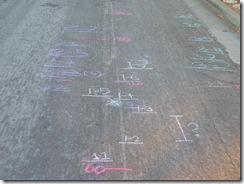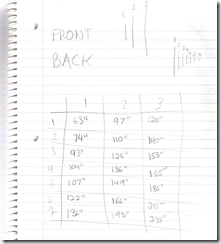I did this the other day with my kids, and they thought it was a lot of fun.
It’s a simple experiment to do with your kids when they ask what the gears on a bicycle do. You’ll need:
- A bike with gears
- Sidewalk chalk
- A measuring tape or stick
- Paper for keeping a table of measurements
I started by making a schematic drawing of the two gear assemblies, front and back (we had a 21 speed bike) and numbered them. Then I made a table with a corresponding number of rows and columns and labeled them.
We went out on our low-traffic street after dinner and drew a starting line close to the curb. Next was getting the gears into the first position: smallest wheel in front, largest in back. Then I explained that we would put the front wheel of the bike right on the starting line and make sure the pedal was in its top position (easy to remember). I asked one of my kids to get on the bike and make exactly one whole turn with the pedal, while I held the bike steady during travel (don’t forget the bike helmet!) We then marked how far the front wheel had traveled and labeled the mark with the gear number combination. Now we changed the gear and did the whole thing over until all gears were covered.
During all this it turned out that holding the bike steady was too much work, and we had to be careful not to "coast" without treading the pedal. So I ended up holding the bike myself, turning the pedal while trying to walk alongside, half on my knees. Plus, we had to speed things up because it was beginning to get dark.
Here’s a picture of our markings (from the next morning):
Just by looking at the markings, we could tell that sometimes you can go approximately the same distance with several different gear combinations.
When we were done with all gears and markings, we got out the measuring tape and measured how far each mark was from the starting line. That resulted in the following table:
We then entered this table into a spreadsheet and turned it into a graph:
Sorting by distance, it looks like this:
This is shows that if you want to go smoothly from the lowest speed to the highest, you have to do a lot of shifting. Some steps aren’t doable without shifting both front and back gear, so in essence you won’t be able to go up smoothly.
Anyway, a fun experiment for after dinner or a weekend afternoon.



